Christmas in July: Here’s Why It’s Time to Start Planning Your Holiday Email Campaigns
Published on July 27, 2018/Last edited on July 27, 2018/8 min read
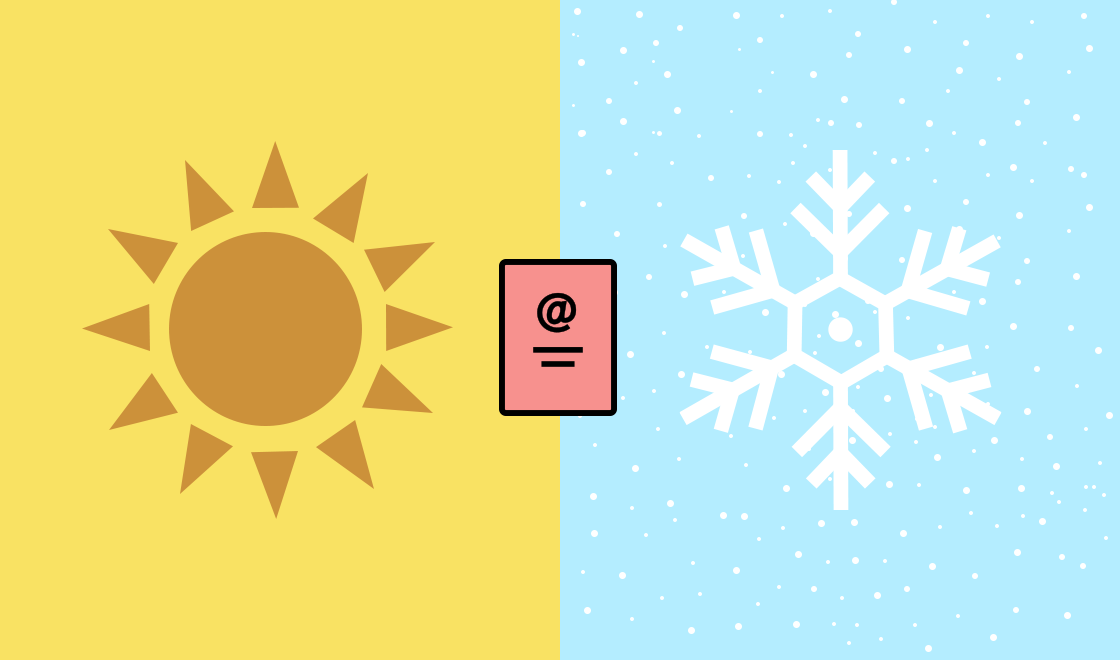

Kelsey Cottingham
Editor, Content Marketing at BrazeRight now, it’s peak summertime—we’re talking 90+ degree temperatures, afternoon downpours, quiet Fridays in the office, and rooftop Instagrams galore over the weekends. But the marketing world slows down for no season, so guess what: it’s time to start thinking about your holiday email campaigns.
I know, I know. Snow feels a long way off, but brands that get their act together now don’t have to spend the fall sweating. To help out, we’ve pulled together desktop and mobile email engagement data highlighting seasonal variations from July and December 2017—and there’s a lot to learn! Start paving the way now for your teams to be strategic (and creative) with your time and the tools at hand, and you’ll be sitting pretty when the holiday season arrives.
So, what seasonal engagement trends do you need to know about?
1. Brands are sending about 80% more emails in December than in July
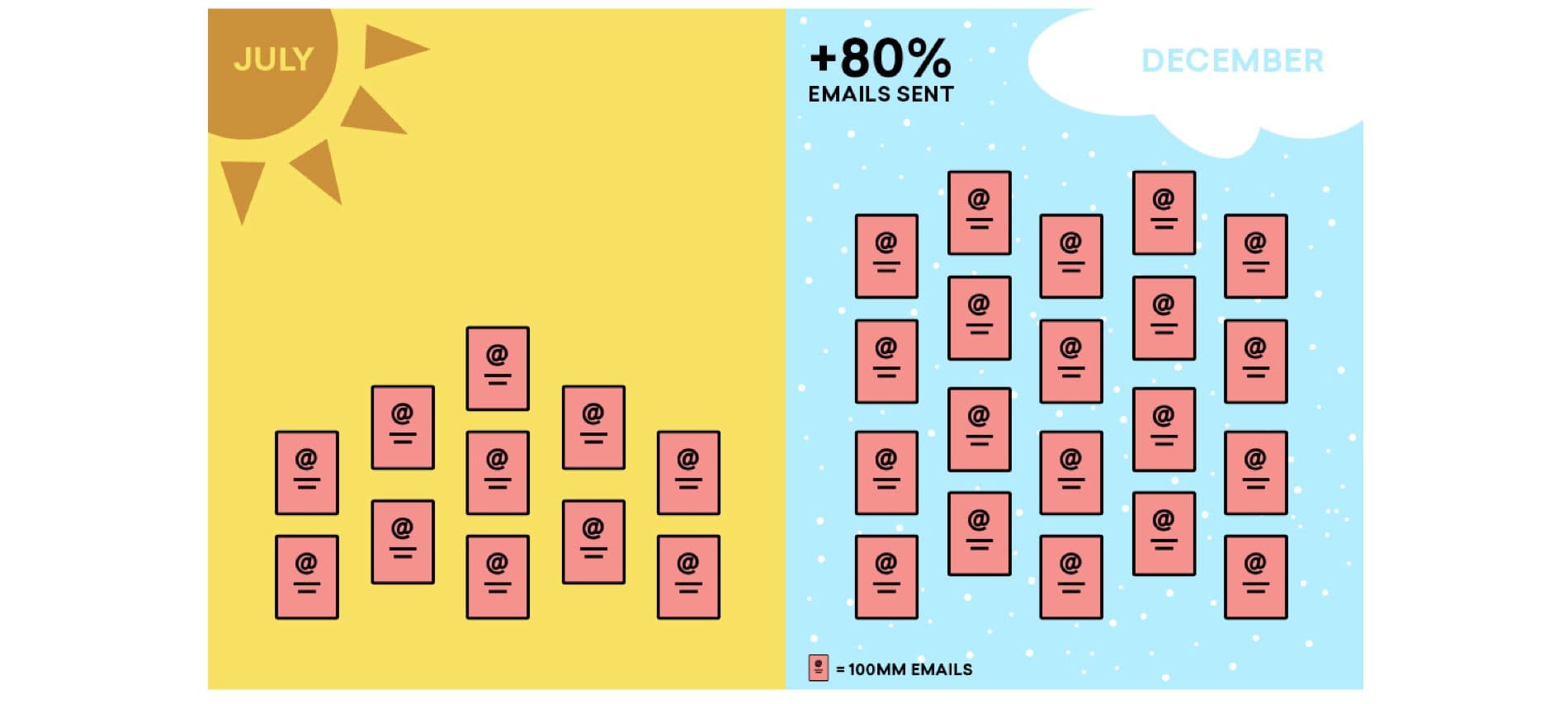
This makes sense. The holiday season and the end-of-the-year period in general can be huge for a company’s bottom line. Plus, we know that the way consumers spend money during the holidays is pretty unique from how they behave the rest of the year. Here’s the catch: sending too many emails (especially if they go unopened) can put you at risk of ending up in the spam folder, damaging your sender reputation with ISPs, and simply getting some extra unsubscribes from people who are overwhelmed by your messaging.
What can you do to start preparing?
Think back to your days of IP warming (and…if that’s not a thing you’ve ever done, you should probably get on it). You’ve got to earn customers’ trust, and the trust of ISPs as well. When you start an IP warm-up with a new IP, you’re essentially teaching ISPs that you’re a trustworthy source of content for customers. If you’re planning on significantly upping your email volume for the holidays, keep in mind those best practices from your IP warm-up like:
- Remove email addresses from your list the first time you get a complaint
- Think impact over effort: send email campaigns that you are confident will perform well. It’s all in the data.
- Slowly increase the number of emails you’re sending leading up to the holidays...instead of suddenly dumping twice your usual number onto your customers.
You can also be strategic about your email subdomains. If you’re worried that your holiday messaging might impact your parent domain or your [email protected], start introducing a new domain now, build a reputation, and save it for special events and tent poles like the holiday season! Bonus? Having a subdomain dedicated to these types of messages can help you to isolate the different results you’re seeing by making it easier to identify which emails are struggling and why. Plus, with the right technology, your emails could be up and running in as little as 4-6 weeks.
2. We send a lot more emails in December… but customers aren’t opening a lot more emails
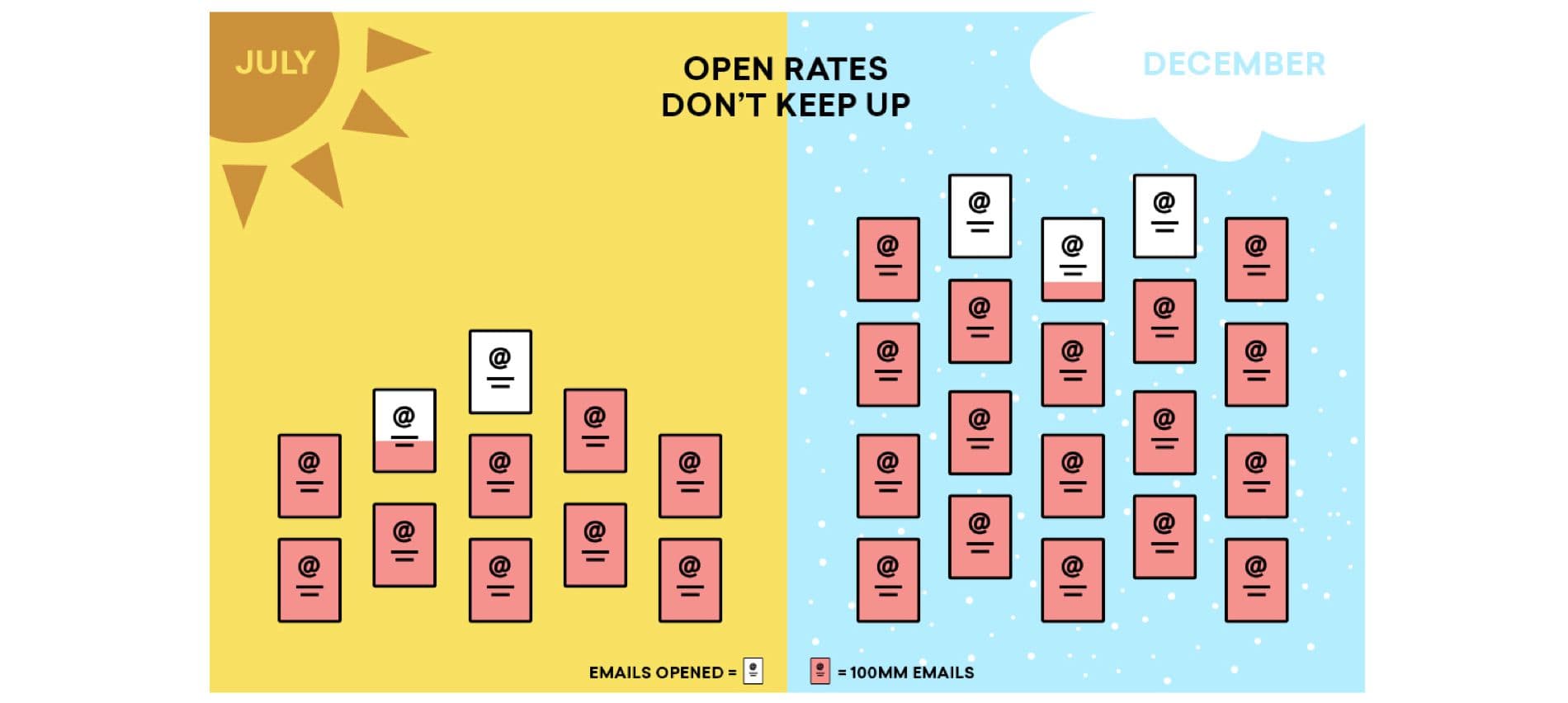
Let’s break this down a little. Since we’re sending emails by the billions, a fraction of a percent in open rates matters. So, effectively, for a volume increase of about 900 million emails, brands only saw about 120 million more opens in December than in July. There’s an effort vs. impact issue here.
Also, bear in mind that many other email senders will be ramping up their volumes for the holidays at the same time you are. The ISPs won’t increase their capacity to receive all of that extra mail. You’ll not only be competing with other senders for your customers’ attention in the inbox, but also for available resources at the ISPs to receive and deliver your mail. It’s doubly important, then, to ensure that your lists are as clean as possible, and your sending reputation is strong beforehand. Senders with the best reputation get priority access to limited ISP resources, and you want to be the one that gets to jump the queue.
Here’s what you can do about it:
To put it simply, you need to get more people opening emails, but the answer is likely not in quantity, so much as quality. If you have the right technology, then you should be able to send emails that are relevant and personal to your individual users, even at the speed and scale of the holiday rush.
Now is the perfect time to really dig in to what’s working and what’s not. Foster a culture of testing among your email, data, and creative teams. Today’s winner could be tomorrow’s control group. Take emoji usage, for example. For a while there emojis in subject lines were a hit with consumers, but just two years later, we’re seeing those results start to reverse. You truly never know until you try, and there’s not going to be a one-message-fits-all answer, but if you’re using a customer engagement platform with a strong intelligence suite, you’ll be able to observe and act on those results in real time and make an informed plan for your holiday messages.
3. The increase in email drop rates is proportional to increase in emails sent.
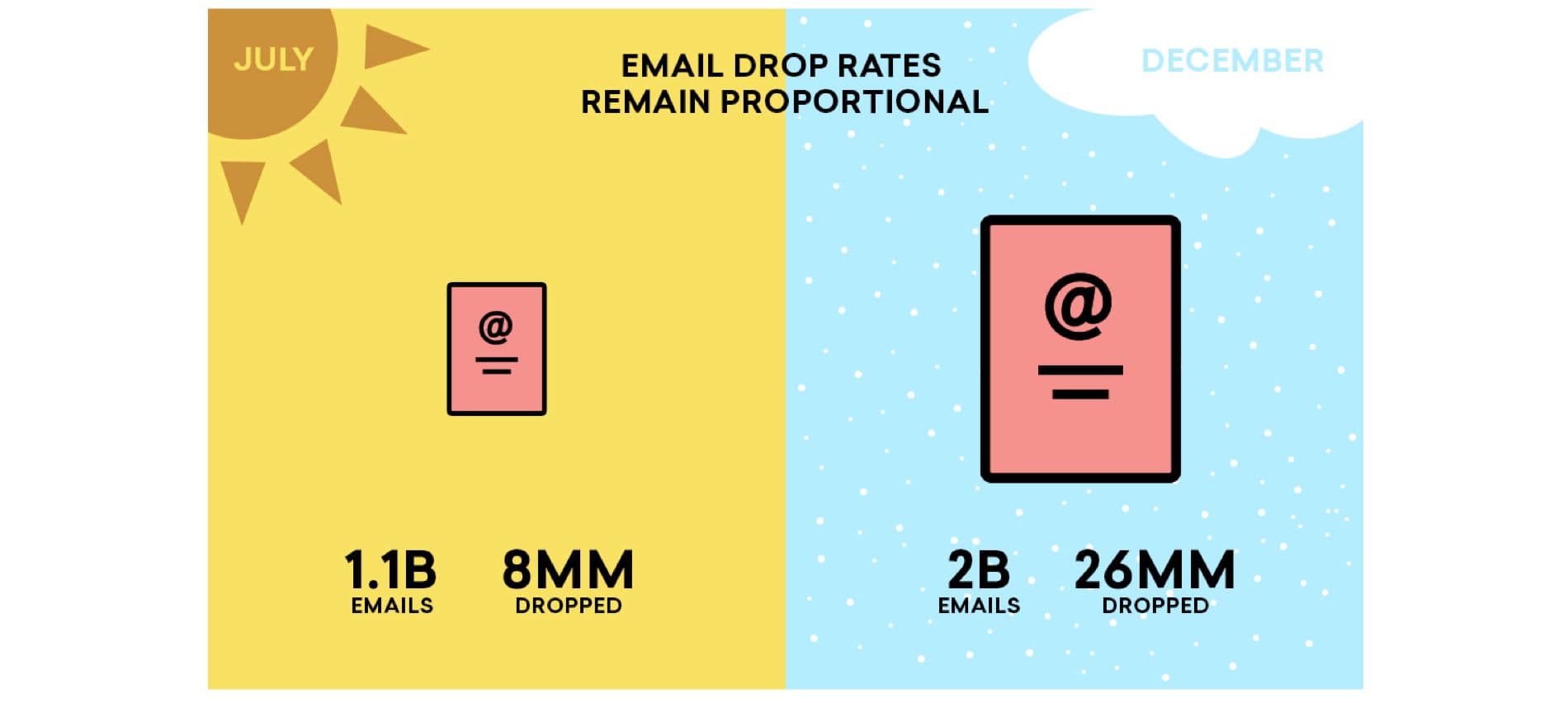
Email drop rates refer to emails that are sent to customers/email addresses that don’t qualify to receive your email. We’re sending about 80% more emails in December than July, and email drop rates for December are about 80% higher than in July. Makes sense. Now, why are we citing a statistic that effectively says “this number stays the same”? Because it represents an opportunity. If you challenge yourself to raise your drop rate in the months leading up to the holiday season, you can reap the rewards when the snow starts to fall.
A high drop rate is good in some ways—it shows that the tools, rules, and segments you have in place are working. Some reasons that an email might drop include:
- Frequency Capping (you’ve sent them too many messages already)
- Exception Rules (they’ve already fulfilled the goal of that email, like completing a purchase)
- Someone has moved out of the segment
Need a head start?
Try running a re-permissioning campaign as the holiday season approaches. You can do this through in-app messages and push in your mobile app, and by starting a sunsetting campaign for disengaged users via email. When users update their preferences, you’ll have a more up-to-date, minimal-guesswork look at how they want to be contacted—and users will feel more in control of their data and messaging.
Then you can take a look at how your campaigns are performing. Did the drop rate significantly increase once users had the opportunity to update their preferences? Good. Keep testing! And bring in some other channels, too. There may be some types of messages that people just don’t want in their inboxes. Maybe they want transactional messages but are not into a constant barrage of promotional messages. Try making email a part of your cross-channel strategy rather than an operational silo. The results can be pretty massive—campaigns with email and at least one other channel see engagement rates jump as much as 543%.
4. The world is your oyster: On average, major industries see a 9.6% increase in unique click rates in Q4 over Q3
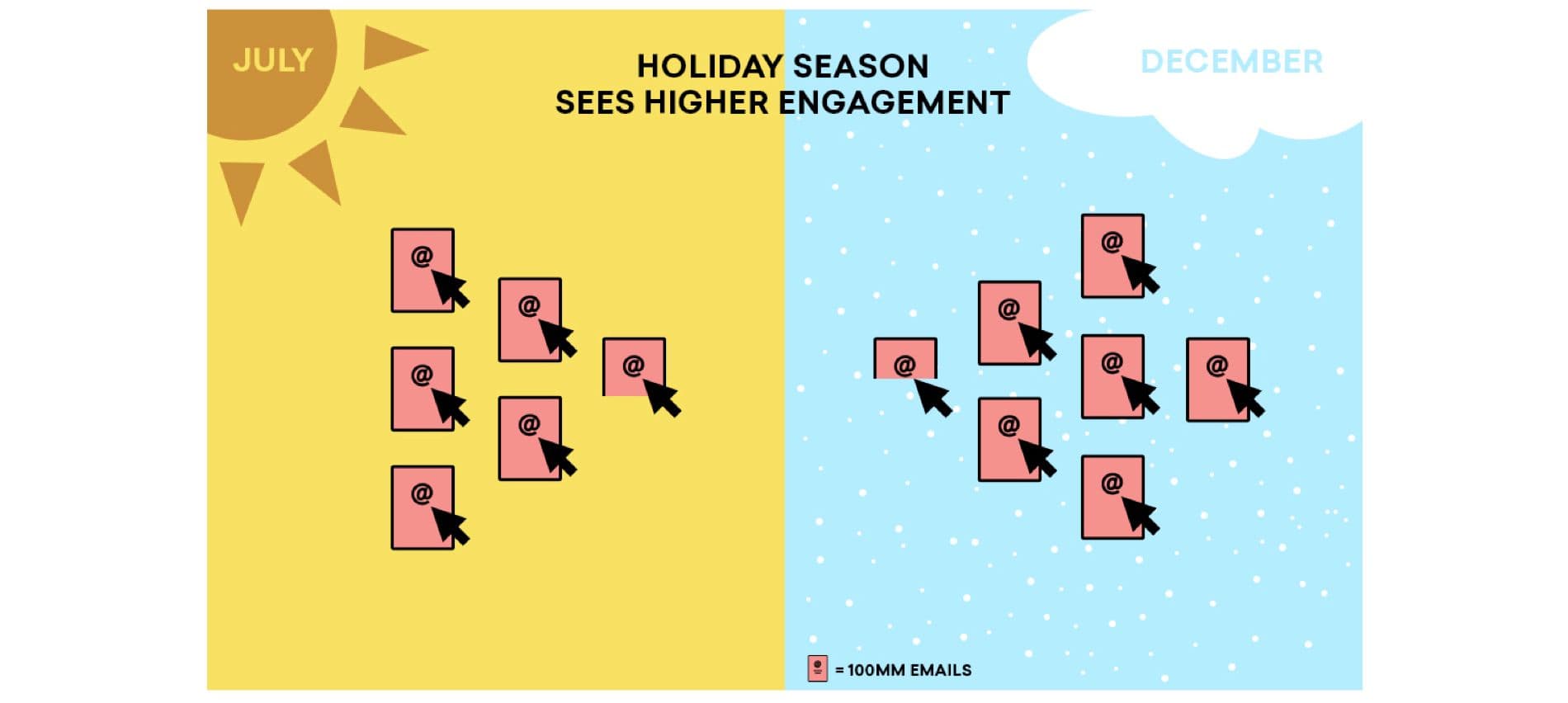
In most major industries, click rates are higher in Q4 (holiday season) than Q3 (summertime). So, once you get your customers to open your emails, they’re likely to be more engaged during the holiday season. All the more reason to start brainstorming with your teams to see how to make every message count.
Let's take advantage of this
In the coming months, lean into retention and engagement. Try to identify the campaigns that show your users you know them, you get them. Make a couple of new power users and brand advocates, maybe lose a few in the process. Your mobile, email, creative, operations, and engineering teams can take the next few months to push the envelope. Try some new ideas, dabble in new technologies, try liquid personalization and dynamic content, test different messages on different channels, and see what people respond to and how it affects your business. Most importantly, take this time to give yourself permission to fail. Your team and your campaigns will be better for it.
Looking to dig deeper into how email and how to use it effectively in today’s cross-platform, cross-device world? Check out our exclusive cross-channel messaging report.
Related Tags
Be Absolutely Engaging.™
Sign up for regular updates from Braze.
Related Content
View the Blog
When buffer management goes wrong: Avoiding bias in AI decisioning models

Kipp Johnson

How AI Decisioning Transforms Marketing (A Complete Guide)

Team Braze

AI decisioning cheat sheet: How to crawl/walk/run with BrazeAI Decisioning Studioᵀᴹ
